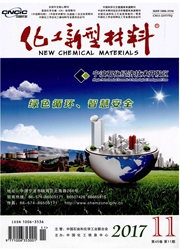

 中文摘要:
中文摘要:
激光熔体静电纺丝法无溶剂的影响符合聚乳酸(PLA)可在生物医学等领域应用的优点。利用激光熔体静电纺丝法制备了PLA微纳米纤维,研究了应用电压、激光电流及接收距离对纤维直径的影响,并利用扫描电镜(SEM)和傅里叶变换红外光谱仪(FTIR)对纤维的微观形貌和分子链结构进行了表征,利用差示扫描量热仪(DSC)和X射线衍射仪(XRD)对纤维的热行为和结晶性进行了表征,同时采用单轴拉力机对热压纤维膜的力学性能进行了测试。结果表明,在可调范围内,所得纤维粗细均匀、表面光滑,直径在5~10μm之间。应用电压及接收距离与纤维直径之间没有明确的关系,纤维直径随激光电流的增加而减小。FT-IR测试表明,激光电纺纤维的分子链结构没有改变。DSC及XRD测试表明,激光电纺纤维为无定形态,在一定温度下退火后呈结晶态。拉力测试结果表明,PLA热压纤维膜的平均断裂伸长率在6%左右,平均拉伸强度为1MPa左右。
 英文摘要:
英文摘要:
Laser melt electrospun polylactic acid(PLA) fibers with no solvent conforms to the advantages of its applications in biomedical.PLA micro-nano fibers were prepared by laser melt-electrospinning,and the effects on fibers diameter were described with applied voltage,laser current and collector instance.The micromorphology and molecular conformation of the fibers were studied by scanning electron microscope(SEM) and Fourier transform infrared spectrometer(FTIR) respectively.The thermal behavior and crystallization were characterized by differential scanning calorimetry(DSC) and X-ray diffraction(XRD),the membranes were tested by strength-strain curve too.With the SEM results,it was proved that the obtained fibers showed a smooth surface and were uniform in diameter,which were between 5μm and 10μm.And there were no certainty relationships between fibers diameter and applied voltage,the relation between diameter and the collector distance were not clear as well.However,the fibers diameter could be decreased with increased laser current.FTIR test showed that the molecular chain structure of the laser electrospun PLA fibers had not changed.DSC and XRD exhibited that the laser electrospun PLA fibers were an amorphous state,and the annealed fibers at a certain temperature were crystalline.Then,tensile curves indicated that the average elongation at break of the PLA fibers membranes were around 6%,and the average tensile strength of the PLA fibers membranes were about 1MPa.
 同期刊论文项目
同期刊论文项目
 同项目期刊论文
同项目期刊论文
 A New Strategy for the Synthesis of Iron-Oxide Nanocrystals by Using a Single-Spinneret Electrospinn
A New Strategy for the Synthesis of Iron-Oxide Nanocrystals by Using a Single-Spinneret Electrospinn Preparation and properties of PET/SiO2 composite micro/nanofibers by a laser melt‐electrospinning sy
Preparation and properties of PET/SiO2 composite micro/nanofibers by a laser melt‐electrospinning sy Direct Formation of Reusable TiO2/CoFe2O4 Heterogeneous Photocatalytic Fibers via Two-spinneret Elec
Direct Formation of Reusable TiO2/CoFe2O4 Heterogeneous Photocatalytic Fibers via Two-spinneret Elec Photocatalytic Activity of Magnetically Separable La-doped TiO2/CoFe2O4 Nano?bers Prepared by Two-sp
Photocatalytic Activity of Magnetically Separable La-doped TiO2/CoFe2O4 Nano?bers Prepared by Two-sp Cell Adhesive and Growth Behavior on Electrospun Nanofibrous Scaffolds by Designed Multifunctional C
Cell Adhesive and Growth Behavior on Electrospun Nanofibrous Scaffolds by Designed Multifunctional C Electrospun Fiber Membranes of Novel Thermoplastic Polyester Elastomers: Preparation and Characteriz
Electrospun Fiber Membranes of Novel Thermoplastic Polyester Elastomers: Preparation and Characteriz Template synthesis and magnetic properties of highly aligned barium hexaferrite (BaFe12O19) nanofibe
Template synthesis and magnetic properties of highly aligned barium hexaferrite (BaFe12O19) nanofibe ~Ag+-loaded polystyrene nanofibrous membranes preparation and their adsorption properties for thioph
~Ag+-loaded polystyrene nanofibrous membranes preparation and their adsorption properties for thioph ~A New Strategy for the Synthesis of Iron-Oxide Nanocrystals by Using a Single-Spinneret Electrospin
~A New Strategy for the Synthesis of Iron-Oxide Nanocrystals by Using a Single-Spinneret Electrospin ~Template Directed Preparation of TiO2 Nanomaterials with Tunable Morphologies and Their Photocataly
~Template Directed Preparation of TiO2 Nanomaterials with Tunable Morphologies and Their Photocataly Functionalization of electrospun magnetically separable TiO2-coated SrFe12O19 nanofibers: strongly e
Functionalization of electrospun magnetically separable TiO2-coated SrFe12O19 nanofibers: strongly e Template-additive-free synthesis of binary zeolite microspheres with tunable hierarchical architectu
Template-additive-free synthesis of binary zeolite microspheres with tunable hierarchical architectu Fabrication Characterization and Activity of a Solar Light Driven Photocatalyst: Cerium Doped TiO2 M
Fabrication Characterization and Activity of a Solar Light Driven Photocatalyst: Cerium Doped TiO2 M Preparation and experimental parameters analysis of laser melt electrospun poly (L-lactide) fibers v
Preparation and experimental parameters analysis of laser melt electrospun poly (L-lactide) fibers v A novel magnetically separable TiO2/CoFe2O4 nanofiber with high photocatalytic activity under UV&nda
A novel magnetically separable TiO2/CoFe2O4 nanofiber with high photocatalytic activity under UV&nda Preparation and Properties of PET/SiO2 Composite Micro/Nanofibers by a Laser Melt-Electrospinning Sy
Preparation and Properties of PET/SiO2 Composite Micro/Nanofibers by a Laser Melt-Electrospinning Sy Template Preparation of Strontium Hexaferrite (SrFe12O19) micro/nano Structures: Characterization, S
Template Preparation of Strontium Hexaferrite (SrFe12O19) micro/nano Structures: Characterization, S 期刊信息
期刊信息
